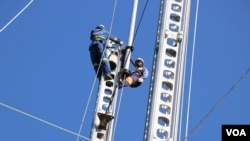Malawi and Mozambique this week launched a power transmission project to help Malawi meet an increasing demand for electricity.
Malawi, one of the poorest nations in Africa, lost 30% of its power generation in January after Tropical Storm Ana destroyed its main power station. The new project is expected to generate 50 megawatts for the country when completed.
The Mozambique-Malawi Regional Interconnector Project was launched during a visit to Maputo by Malawi's President Lazarus Chakwera.
Chakwera said the project was historic because it will establish a reliable power connection not only between the two countries but also across the Southern Africa Development Community, or SADC, a regional economic organization comprising 16 member nations.
The power line has the potential to increase trade opportunities, he said, and will also create over 1,000 jobs for Malawians and Mozambicans.
Innocent Chitosi, spokesperson for the Electricity Supply Corporation of Malawi, or ESCOM, said the project would help the corporation meet Malawi’s growing demand for electricity.
"The projected demand is hovering around 550 [megawatts]," Chitosi said. "It keeps on changing of course with time, but we are able to produce on a stable basis around 350 megawatts, so you can see the gap. But also you know that if we have a better source of power, maybe the demand may increase.”
The $154 million interconnector project is being funded by the World Bank, the European Bank and the German state-owned bank KfW.
Power purchases
When the transmission line is finished, Malawi is expected buy about 50 megawatts of power from Mozambique — about 12 percent of the country’s needs.
However, Chitosi said the country could purchase more megawatts if the need arose.
"Basically, there shall be no time when we shall say, ‘This is enough,’" Chitosi said. "You know that the president’s vision is to have 1,000 megawatts by 2025. So, we have now negotiated for an additional 60 megawatts, making it 110. And we have room to request for more power supplies from the Mozambican side.”
But economic experts feel the project will not be economically viable unless Malawi becomes more industrialized.
Betchani Tchereni, a lecturer in economics at Malawi University of Business and Applied Sciences, said, "Our economic activities are limited in such that, yes, we are going to have electricity, but if we are going to use that electricity for consumptive purposes only, then there is no point in going into this. But if we are going to use that electricity for purposes of industrialization and production, then we are good.”
Tchereni said Malawi should exhaust all means of power generation at its disposal, like solar and wind energy, before it starts buying electricity from Mozambique.
Chitosi, however, said the project is just one among many Malawi has undertaken to mitigate the shortage of power.
In 2015, Malawi’s government liberalized the power sector, which was monopolized by the state-run ESCOM power transmission and distribution company, and allowed operations of the independent power suppliers.
The target date to complete the new power line is October 2023.








